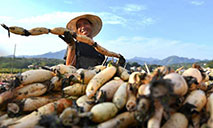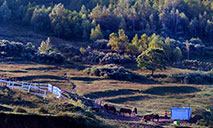National park sees more tiger, leopard cubs in China
CHANGCHUN, Oct. 10 (Xinhua) -- China's pilot national park project for endangered Siberian tigers and Amur leopards has borne fruit, with wildlife populations on the rise.
At least 12 Siberian tiger cubs and 11 Amur leopard cubs have been born since 2017, when the Northeast China Tiger and Leopard National Park pilot project was launched in the provinces of Jilin and Heilongjiang, according to the park's management bureau.
Populations of other wild animals, such as spotted deer and boars, are also on the rise, suggesting an improving eco-environment in the park that spans 1.46 million hectares.
Over the past four years, the forest stock in the park has risen from 212 million cubic meters to 223 million cubic meters.
Local authorities regularly send forest rangers to patrol the park and the neighboring area and clear traps set by poachers.
Siberian tigers, also known as Amur tigers, mainly live in Russia's Far East and northeast China. One of the world's most endangered species, about 500 Siberian tigers are believed to be living in the wild.
Amur leopards, also known as the Far Eastern leopard, are also one of the most endangered felines in the world and have been listed as critically endangered by the International Union for Conservation of Nature.
Photos
Related Stories
- China establishes a protected areas system with national parks as its mainstay
- National parks can effectively alleviate isolation of wild giant panda population: research
- People visit Rila National Park during tourist season in Bulgaria
- SW China forum focuses on building national cultural park
- Going with the flow at China's first national park
- China’s national park system starts to yield fruits
- China starts process of formalizing 10 pilot national parks
- Pilot projects underway for 10 national parks in China
- First National Park Forum opens in northwest China
- Xi sends congratulatory letter to first National Park Forum
Copyright © 2021 People's Daily Online. All Rights Reserved.










